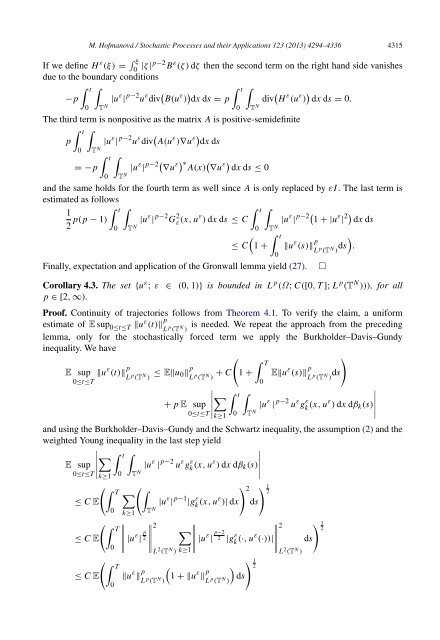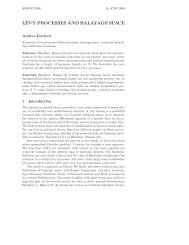Degenerate parabolic stochastic partial differential equations
Degenerate parabolic stochastic partial differential equations
Degenerate parabolic stochastic partial differential equations
You also want an ePaper? Increase the reach of your titles
YUMPU automatically turns print PDFs into web optimized ePapers that Google loves.
M. Hofmanová / Stochastic Processes and their Applications 123 (2013) 4294–4336 4315<br />
If we define H ε (ξ) = ξ<br />
0 |ζ |p−2 B ε (ζ ) dζ then the second term on the right hand side vanishes<br />
due to the boundary conditions<br />
t <br />
−p |u ε | p−2 u ε div B(u ε ) t <br />
dx ds = p div H ε (u ε ) dx ds = 0.<br />
0 T N 0 T N<br />
The third term is nonpositive as the matrix A is positive-semidefinite<br />
t <br />
p |u ε | p−2 u ε div A(u ε )∇u ε dx ds<br />
0 T N t <br />
= −p |u ε | p−2 ∇u ε ∗ <br />
A(x) ∇u<br />
ε dx ds ≤ 0<br />
0 T N<br />
and the same holds for the fourth term as well since A is only replaced by εI . The last term is<br />
estimated as follows<br />
<br />
1<br />
t <br />
t <br />
2 p(p − 1) |u ε | p−2 G 2<br />
0 T N ε (x, uε ) dx ds ≤ C |u ε | p−2 1 + |u ε | 2 dx ds<br />
0 T N<br />
t<br />
≤ C 1 + ∥u ε (s)∥<br />
.<br />
p L p (T N ) ds<br />
Finally, expectation and application of the Gronwall lemma yield (27).<br />
Corollary 4.3. The set {u ε ; ε ∈ (0, 1)} is bounded in L p (Ω; C([0, T ]; L p (T N ))), for all<br />
p ∈ [2, ∞).<br />
Proof. Continuity of trajectories follows from Theorem 4.1. To verify the claim, a uniform<br />
estimate of E sup 0≤t≤T ∥u ε (t)∥ p is needed. We repeat the approach from the preceding<br />
L p (T N )<br />
lemma, only for the <strong>stochastic</strong>ally forced term we apply the Burkholder–Davis–Gundy<br />
inequality. We have<br />
<br />
T<br />
E sup ∥u ε (t)∥ p L<br />
0≤t≤T<br />
p (T N ) ≤ E∥u 0∥<br />
1 p L p (T N ) + C + E∥u ε (s)∥ p L<br />
0<br />
p (T N ) ds <br />
t <br />
+ p E sup<br />
|u ε | p−2 u ε g ε<br />
0 T N k (x, uε ) dx dβ k (s)<br />
<br />
0≤t≤T<br />
k≥1<br />
and using the Burkholder–Davis–Gundy and the Schwartz inequality, the assumption (2) and the<br />
weighted Young inequality in the last step yield<br />
<br />
t <br />
E sup<br />
|u ε | p−2 u ε g ε<br />
0≤t≤T<br />
k≥1 0 T N k (x, uε ) dx dβ k (s)<br />
<br />
<br />
T 2 1<br />
2<br />
≤ C E<br />
|u ε | p−1 |g ε<br />
T N k (x, uε )| dx ds<br />
0<br />
k≥1<br />
T<br />
≤ C E<br />
|uε | p 2<br />
<br />
0<br />
2<br />
L 2 (T N ) k≥1<br />
<br />
|uε | p−2<br />
2 |g<br />
ε<br />
k (·, u ε (·))|<br />
<br />
T <br />
<br />
≤ C E ∥u ε ∥ p 1 + ∥u ε ∥ p ds<br />
L p (T N )<br />
L p (T N )<br />
0<br />
1<br />
2<br />
0<br />
2<br />
L 2 (T N )<br />
ds<br />
□<br />
1<br />
2



